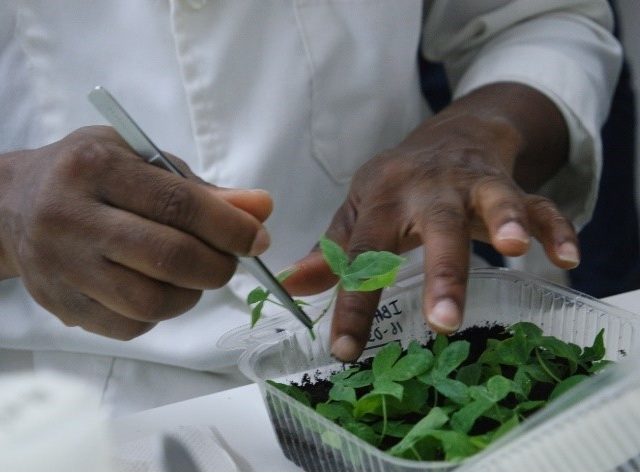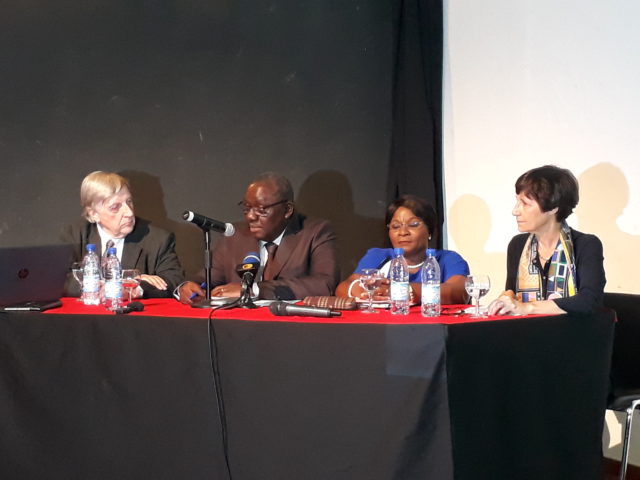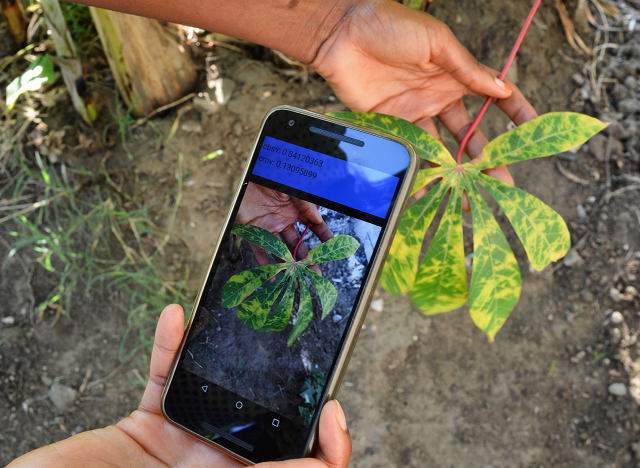By Graham Thiele
I visited NRI offices and labs near to Chatham, England earlier this year. I began the day with Andrew Westby, the enthusiastic director, who explained the full breadth of their work with roots and tubers. They are definitely big players in the field and many of their projects are directly related to what we do in RTB.
John Orchard and David Phillips, for instance, are supporting yam seed system development in West Africa. The main challenge is linking farmers to seed growers and scaling up for commercial production, David concluded after field visits. The economics of seed multiplication hinges on the cost of foundation seed, and broader multiplication depends on creating a community-based seed system.
Next stop was a chat with John Colvin, Sue Seal and Maruthi Gowda, who are using a holistic approach to understanding viruses and their spread, integrating knowledge of the disease, vectors, molecular diagnostics and bioinformatics. They explained that superabundant whiteflies, vectors for the transmission of brown streak virus, seen in late 1990s was a problem waiting to happen. There was a clear match between spread of whitefly and brownstreak. So it really wasn’t a matter of chance that cassava brownstreak virus spread in Uganda in 2004 with devastating consequences. The topic is of utmost importance to RTB. We are supporting the Global Cassava Partnership for the 21st century (GCP21), that earlier this year raised the alarm on new outbreaks and the spread to West Africa, where NRI also took part. Research lines being pursued in NRI include identifying genes for resistance to brown streak in elite lines provided by IITA and national research programmes in East Africa, and understanding the genome of whiteflies. John and Sue also pointed out the similar and significant risks of neglecting the management of whitefly populations on sweetpotato and the associated emergence of new virus diseases. They mentioned, in particular, the recent disturbing development of very high numbers of whitefly on sweet-potato in Uganda, which they identified as two of the most invasive and destructive species (MED and MEAM1) within the Bemisia tabaci species complex.
Another threat to sweetpotato is studied by Phil Stevenson, who collaborates with the Uganda sweetpotato program and North Carolina State University to identify genetic sources of and QTLs for resistance to sweetpotato weevils. Phil explained that long chain hydroxycinnamic acid esters prevalent in resistant varieties reduce oviposition and feeding by adults and stop larva reaching pupation. There are no anti-nutritional effects for consumers since these compounds occur in all varieties but vary in their quantities on the root surface. Segregating populations from a cross between the resistant African variety and a full mapped susceptible US variety is currently being studied to identify loci for resistance, so this looks like a promising new option to control this damaging pest.
Postharvest work is also big in NRI. Ben Bennett, Andy Graffham and David Phillips work on improving cassava processing in Africa with a focus on high quality cassava flour (HQCF) in the C:AVA project. They explained that large scale flash dryers proved not to be economically viable so the emphasis shifted to local flash dryers with a capacity around 250 kg per hour. Here they were able to substantially lower costs running dryers on cheaper fuel sources such as palm kernels and using a heat exchanger. These flash dryers are being acquired by the private sector in Nigeria, and market development is shifting to large numbers of small users such as bakers. Dominique Dufour, (CIAT and CIRAD) who leads our postharvest theme, Genevieve Fliedel (CIRAD), Bussie Maziya Dixon (IITA) and Keith Tomlins (NRI) are currently planning work on consumer acceptability in the framework of a new RTB postharvest project on cassava processing which should bring us closer together.
John Morton and Lora Forsythe are part of a strong social science group. They have contributed to developing an M&E framework for the C:AVA project). The framework matches differing country strategies and stakeholder needs. John explained work on a gender and diversity audit of organizations in five countries and how they looked at some of the tradeoffs for technological change with a gender lens. Laura, for example, pointed out that women sometimes preferred working with HQCF because of the health problems from smoke in traditional processing of gari, although it has been a major source of income for them.
I also gave a very well attended seminar about current RTB thinking to NRI staff, and the exchanges that followed confirmed multiple options for a closer partnership. I left Chatham very impressed with the wide range of competencies housed in a single institution.
 |
 |
| Women and men members of the SSOSPA farmers organization in Eastern Uganda making HQCF with support from the NRI led C:AVA project | |
 |
 |
| Flash dryer for HQCF production at Nobex, Nigeria with C:AVA, EU FSTP Cassava Growth Market and EU FP7 Gratitude project team members | Collaborative team in Uganda in the field for value chain assessment and investment appraisal for cassava value addition (C: AVA project) |



